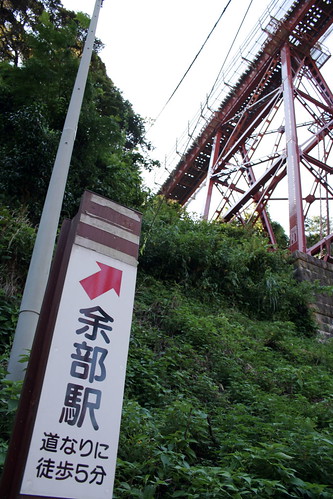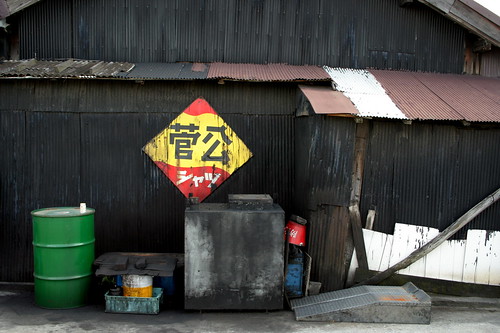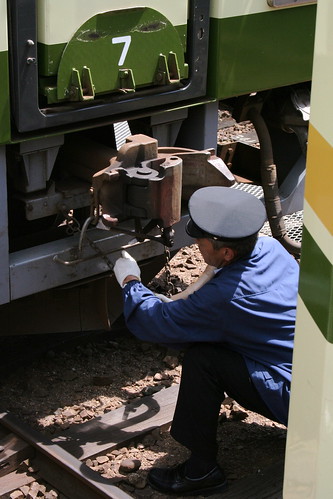Sunday, December 30, 2007
Things I Miss About America: Mexican Food
So, if you haven't guessed, I'm in America for a week. So I'm going to focus on some things I miss about America for the next week. Number one: Mexican food in Tucson. Soooo good. We had fish tacos, a pork burrito, and a fish burritos.
This is from the b-line on 4th Ave. in Tucson. おすすめ!
Monday, December 24, 2007
Santa Claus Spotted In Japan, Buying Tea, Saying "Ho Ho Ho!"
It seems that Santa needed a warm pet bottle of green tea today in Hyogo, Japan. Santa also showed his adoption for new technologies, paying for his tea with a Nanako enabled cell phone. But beware this Santa although he looks friendly is known for calling out "Merry Christmas" in his loud jolly voice to unexpecting Japanese folks.
Tuesday, December 11, 2007
Battle of the vending machines.
Chips & Salsa... Konbini Style
Step 1: Open top. Remove salsa and chip packets.
Step 2: Following the directions on the chip packet, open chips and salsa packets. Empty contents into their given places in the tray.
Wednesday, October 31, 2007
Japanese Landscape: Old Style Apartment Block
Osaka Pref., Fujiidera city
大阪府藤井寺市
I’ve seen and posted many photos of similar apartment buildings but have yet to explain them. this simple two story apartment block was very popular in the post war years. Yuko told me that prior to the Great Hanshin Earthquake these were quite common in her neighborhood but were replaced after the earthquake. In general the entire area has gone through a great deal of gentrification in the last 10 years.
PLEASE FOR HEALTHY LIFE
Engrish Eggs!
Osaka Pref., Fujiidera city
大阪府藤井寺市
FRESH
EGGS
IT’S... COUNTRY
BRED.
PLEASE FOR HEALTHY LIFE
Monday, October 29, 2007
Okadera and Nara Park
While the rest of the gaijin community is getting flustered over this, I’d rather go to cool temples. Yuko’s Mom has been on a route going to various temples around Kansai and getting a scroll signed and stamped at each one. This is much like the famous 88 temple route in Shikoku. Sadly I’m not that well versed on Buddhism and I cannot explain the meaning behind it all, but I can say that the temples are beautiful. Okadera (lit. hill temple) was especially beautiful.

A view of main temple of Okadera from the walking path that circles the temple grounds.

A moss and fungus covered tree stump on the grounds of Okadera

A lady selling drinks and snacks near the public restrooms in Nara Park

A priest signing the temple's name in Nara Park.
The rest of the photos from this trip can be found in this set.
Firestorm
I look back upon it as an incredible experience. Maybe one that has made me stronger in the face of other disasters and made me less connected to things in a way that makes living abroad easier.
These are the few photos from the event that I have on my computer.
Sunday, October 21, 2007
Two views of rural detritus in Nara prefecture.
1. The Pachinko Parlor
The popular past-time of grandpas has fallen on hard times. Due to changes in gaming laws and pressure from the government pachinko parlors have turned away from big reward-big loss scenarios in favor for low risk-low reward gaming. This has turned away the hardened gamblers. While it still remans profitable, it can no longer pull in as many customers. Those parlors in older centrally located shotengai (shopping streets) like this one have closed down as more people head to larger shopping centers and pachinko parlors on the outskirts of town.
2. The related businesses
This cafe next to the pachinko parlor also went the same way as it's neighbor. One can imagine that it sustained on serving those going to or leaving the neighboring pachinko parlor. Whether or not it is related to the pachinko parlor’s closure is unknown; nevertheless the two events are tied to the general aging of city centers. The urban renewal movement that is rebuilding many of America's downtowns has yet to come to Japan--at least in the same way. I don't know if shotengai (shopping streets), sento and the like are under the threats that their counterparts in America have faced either. Crime being the most important of those threats. Also, suburban development and subsequent shopping centers are servicing a new and expanding lifestyle choice for many Japanese--especially young families.
Old and deterioating shotengai, such as this one I found in Nara prefecture, have an atmosphere and style that is worth paying attention to.
Wednesday, October 10, 2007
Be The Best Bacon For The Fans?
The Hanshin Tigers have their own bacon now. It's not too bad either! I bet you'll not find this for sale up in Tokyo.
Sunday, October 07, 2007
Japanese Landscape: Night in the City
Osaka's night time sky.
Early morning in the city after the last trains have run has an amazingly tranquil feeling, but that tranquility is like a thin fog over the early morning festivities which hide around every corner, under every tree, behind every sign.
Tuesday, October 02, 2007
Japanese Landscape: Wakayama City
Japanese Vernacular Landscape: Oshibori delivery
Oshibori are damp hand-towels that are given out at restaurants. Commonly one of the things that people miss about Japan when they return home. I love them to. Most cheaper places have plastic wrapped paper oshibori, but many restaurants use cotton ones. These are delivered typically in the morning before most restaurants open for lunch where they are put into heaters or coolers, depending on the season, for customers. Companies like KCC deliver the fresh wrapped oshibori for the previous days used ones for washing and reuse.
This photo was taken in around 10:00 AM in Umeda.
Monday, August 20, 2007
Summer San-in Train Trip
This time I made a circle route from Sanda to the Japan Sea coast then down the back side of the country crossing back over to Okayama then back up to Kobe and home. I’ve been on various parts of this route 2 years before during winter when my Japanese was worse, and Japan travel skills were only in their beginner stage. Which made this trip so much better as I was able to compare my first experience with my most recent one.
Day One: Sanda to Tottori
Sanda -> Fukuchiyama (Fukuchiyama Line) 三田 -> 福知山 (福知山線)This got me out into the middle of the country.
Fukuchiyama -> Kinosaki Onsen (San-in Main Line) 福知山 -> 城崎温泉 (山陰本線)
Here I changed on to the rail line that follows the Japan Sea side of the country.
Kinosaki Onsen -> Amarube (San-in Main Line) 城崎温泉 -> 餘部 (山陰本線)
Here I got off to admire a great steel bridge spanning a small seaside valley. The bridge has always been a favorite among train fans, but recently the bridge was slated for replacement by a more typical concrete one. This bridge was also made famous by an accident that occurred there when a train was blown off the bridge by a gust of wind.
The interest that has been created has led to many people coming to photograph the bridge and the locals selling souvenirs.
I also took my first swim in the Japan Sea during this trip. My friends warned me of jellyfish but I didn’t see any.

Here I just changed on to a continuing train to Tottori.
Hamasaka -> Tottori (San-in Main Line) 浜坂 -> 鳥取 (山陰本線)
In Tottori I took a bus to the Tottori Sakyu Japan’s largest sand dune.
I also found a little onsen to go to thanks to the lovely people at the information desk in the station.
Tottori is a prefectural capital and a regional transit center, but it’s also a great town. Both times that I have been I’ve found a great bar to go to. This time I stumbled upon noppo and had a great time chatting with the locals.
Day Two: Tottori to Nima to Matsue
Tottori -> Yonago (San-in Main Line) 鳥取 -> 米子 (山陰本線) Yonago -> Nima (San-in Main Line) 米子 -> 仁万 (山陰本線)I decided to head further down the San-in coast to the Nima Sand Museum. I wanted to go to this museum last time I came through here, but I didn’t have the time this time. The Sand Museum is home to the world’s largest hourglass which times out an entire year.
They had sand samples from around the world, even Arizona!
After checking out the Sand Museum I had almost 2 hours to wait for the next train so I found a local onsen hotel and was able to take a quick bath and get out of my sweat soaked clothing.
Nima -> Matsue (San-in Main Line) 仁万 -> 松江 (山陰本線)
I returned to Matsue found a local hotel to stay at. That night I found a great local bar and chatted with the locals.
Day Three: Matsue to Kobe via Okayama
Matsue -> Shinji (San-in Main Line) 松江 -> 宍道 (山陰本線) Shinji -> Bingo Ochiai (Kisuki Line) 宍道 -> 備後落合 (木次線)The Kisuki line was probably the most remote line that I took during my trip which is famous for its switchback. It went through tight valleys up into the mountains that make up the spine of Honshu. When we began on the trip from Shinji station the train was made up of two cars which despite the crowded conditions on the front car the back car was closed off. Most of that crowding on the train was travelers on the Seisun 18 Kippu like me including two families. I couldn’t help but think that I would be dragging my children on some middle of nowhere train trip like this in the future.
About half way on the line the train stopped an they disconnected the rear car sending it back to Shinji station.
Bingo Ochai -> Nimi (Geibi Line) 備後落合 -> 新見 (芸備線)
One train heading West the other heading East in the center of Honshu, both waiting for us.
Nimi -> Okayama (Kishin Line and Inbi Line) 新見 -> 岡山 (姫新線 と 因美線) Okayama -> Shin-Kobe (Sanyo Shinkansen ) 岡山 -> 新神戸 (山陽新幹線 ) In Okayama I was able to find a small local sento thanks in part to two local English teachers that I bumped into in a shopping arcade.
Because it was around 7PM when I was done with the sento and aching to get back home, I put out the cash for a Shinkansen ticket and had to stand next to the bathroom for my 35 minute non-stop ride to Shin-Kobe.
Food from the trip.
Due to historical, political and geographical reasons Japan has a regional mentality. This is augmented by a gift giving culture and giving a give that is branded with the place is quite important. Also, having locally produced and sourced food is also quite important. This has led to the development of ekiben, more photos here on the Japanese Wikipedia ekiben entry, which are box lunches sold at train stations. These are different depending on the station.
This is pressed tai sushi served in a wooden box from Kinosaki Onsen station.
This is some dehydrated beef I also got from Kinosaki Onsen station. This must have been one of the best things I’ve ever ate.
This is a Tottori beef donburi that came in it’s own self heating bowl.
This is local Tottori beer, I can’t remember the brewery’s name but I went to their restaurant near Yonago 2 years ago and loved it. Maybe the best micro-brew in Japan. Their GeGeGe no Kitaro themed labels are pretty cool.
It was a great trip and I really, really was reminded about how much I love this country and how much I love living here. I can’t recommend the Seishun 18 Kippu enough.
You can check out all my photos here!

















































